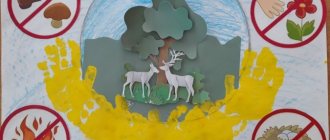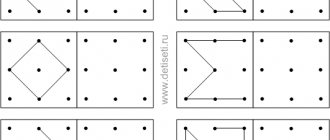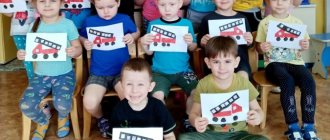Preparatory group. Senior preschool age. Children 6-7 years old
Summary of joint research activities with children of the preparatory school group “In the kingdom of snow and ice” “In the kingdom of snow and ice”
Objectives: - clarify the properties of snow and ice; - repeat the rules of behavior during a walk; - exercise the ability to conduct simple experiments with snow and ice; — learn to negotiate with each other when working in a subgroup. Progress: Cognitive motivation….
Summary of GCD in the preparatory group “We are researchers” Area: knowledge “We are researchers ”
. Program content: - introduce children to some properties of water: water is transparent, water has no odor, water is a liquid, some substances dissolve in water and others do not; - generalize and clarify children’s knowledge about air and its properties:...
Cognitive and research project in the preparatory group of a preschool educational institution
Cognitive and research project “Sorceress-Salt” with children of the preparatory group.
Goal:
developing an idea of salt as a necessary product for humans through observation and experimentation.
Objectives:
Find out whether it is possible to do without salt?
What is it for? Investigate the properties of salt experimentally. Conduct experiments on growing salt crystals. Project defense:
After reading the fairy tale “Gold and Salt” to the children, the children had a question: “Where does salt come from?”
The children began to argue that we eat salt every day, and it comes in different forms: coarse, fine, sea, colored, rock, table salt. One of the guys said that salt is mined on land and water. The children were very interested in this and we decided to explore salt and learn everything about it. A little history: Salt appeared in human life in ancient times. How exactly people learned that food seasoned with white grains tastes better and lasts longer is no longer known. But as soon as people learned the taste of salt, they began to value it extremely. The area, rich in its deposits, was quickly populated and became the property of a tribe. Salt is found in common foods such as cottage cheese, cheese, bread, cookies or cornflakes. There is enough salt in dairy products, vegetables and meat for a person not to lack it. Salt is found in vegetables and some fruits. Salt is an important seasoning, without which food is bland. Vegetables are prepared with it for the winter (cucumbers, tomatoes, cabbage are pickled). Salt is also a symbol of hospitality and friendship. “Sharing bread and salt” meant maintaining a long-term relationship. Hence the popular sign - spilling salt means quarrel, failure. Salt has always been treated with respect and sparingly. There are also many sayings associated with salt. We learned some of them: Under-salting on the table, over-salting on the back. Without bread you are not full, and without salt you are not sweet. Salt was brought to Kievan Rus from salt lakes on the Black and Azov Seas. Here it was bought and taken to the North. Salt was so expensive that at ceremonial feasts it was served on the tables of noble guests, while others dispersed “without salt.” After talking with my mother, we learned some tricks related to salt. For example, to prevent hot vegetable oil from splashing in different directions in a frying pan, you need to sprinkle the hot oil with salt. To easily peel boiled chicken eggs, add a little salt to the water in which they will be boiled. How to determine the freshness of a chicken egg? Add a teaspoon of salt to a cup of water. Place an egg into the solution. If it floats up, it’s better not to use it, but if it drowns in such water, it’s most likely fresh. Adding a pinch of salt to a jug of fresh milk will help it last longer. We developed and discussed a detailed plan for studying salt. We set ourselves goals and objectives: to study the properties of salt, grow salt crystals, study and compare salt and fresh water. We recorded all our observations and experiences in an observation diary. This is how much interesting we learned about salt. But she really is magical. No wonder people say: if there is no salt, there is no word! Diary of observations and experiments in the project “Salt is a magician”. How did our research begin? First we studied the properties and qualities of salt. We found out that the salt tastes salty, is white, odorless, and free-flowing. 1. Salt dissolves in water. We took a container with water, immersed a spoon with salt in it - the salt disappeared from it. Conclusion: salt dissolves in water.
2.Salt in water of different temperatures. We took two glasses of cold and hot water. And they put one heaped tablespoon of salt in each of them. The water in the glasses became cloudy. But in a glass of hot water, the salt dissolved faster, and the water was almost clear. And in a glass of cold water, the salt fell to the bottom, but the water itself remained cloudy for a long time. Conclusion: salt dissolves faster in hot water.
3.Floating egg. Let's conduct an experiment and check how salt water will push objects to the surface! To conduct the experiment we will need: 2 raw eggs, 2 glass containers with water, several tablespoons of salt. Place one raw egg in a container with clean tap water. What happened to him? The egg sank to the bottom. Dissolve the salt in a second vessel with water and lower the egg into the salt water. The egg was left floating on the surface of the water! Conclusion: Salt really does push things out of water. The more salt there is in the water, the more difficult it is to drown in it.
4. Obtaining crystals. We took a small saucer, poured water into it, added salt, stirred it and left it on the radiator overnight. In the morning, the water in the saucer evaporated, leaving large salt crystals at the bottom. We learned that when salt water evaporates, crystals form. 5.Salt is a cleaning agent. We took a dirty glass, poured a little salt on a sponge and washed the glass. It became clean, even shiny. Conclusion: You can use salt to wash dishes.
It was very interesting for us to work on this topic. We asked our parents what they know about the beneficial properties of salt for people’s lives. It turns out that parents know a lot and they were happy to share their knowledge with us. And we talked about what we had learned ourselves when we carried out observations and experiments, and read the encyclopedia. We also became convinced that the simplest and most familiar things can be unusual. After finishing the project, we learned: Salt is a white crystalline substance with a pungent, salty taste. It dissolves well in water. Salt is a mineral that is used by humans in everyday life and in production. Salt is a helper in the household. Salt is a food and seasoning, a preservative. Salt is essential for human life and health. When salt water evaporates, white crystals appear that taste salty.
We recommend watching:
Project in a kindergarten for older preschoolers 5-7 years old on legal topics Project in the senior group of a kindergarten Project in a senior group on the topic “Trees and shrubs in spring” Practice-oriented project for landscaping the territory of a kindergarten
Similar articles:
Educational and creative project on the theme “Golden Autumn”. Junior group
Project for children of the senior group “Our cheerful garden”
Card index of educational and research activities in the preparatory school group
Equipment:
1. Ice and snow in a small saucepan with a lid.
2. Electric stove.
3. Refrigerator (in a kindergarten, you can agree with the kitchen or medical office to place a test saucepan in the freezer for a while).
Experience 1:
Let's bring hard ice and snow home from the street and put them in a saucepan. If you leave them in a warm room for a while, they will soon melt and you will get water. What was the snow and ice like? The snow and ice are hard and very cold. What kind of water? It's liquid. Why did solid ice and snow melt and turn into liquid water? Because they got warm in the room.
Conclusion: When heated (increasing temperature), solid snow and ice turn into liquid water.
Experience 2:
Place the saucepan with the resulting water on the electric stove and boil. The water boils, steam rises above it, the water becomes less and less, why? Where does she disappear to? It turns into steam. Steam is the gaseous state of water. What was the water like? Liquid! What did it become? Gaseous! Why? We increased the temperature again and heated the water!
Conclusion: When heated (increasing temperature), liquid water turns into a gaseous state - steam.
Experience 3:
We continue to boil the water, cover the saucepan with a lid, put some ice on top of the lid and after a few seconds we show that the bottom of the lid is covered with drops of water. What was the steam like? Gaseous! What kind of water did you get? Liquid! Why? Hot steam, touching the cold lid, cools and turns back into liquid drops of water.
Conclusion: When cooled (temperature decreases), gaseous steam turns back into liquid water.
Experience 4:
Let's cool our saucepan a little and then put it in the freezer. What will happen to her? She will turn into ice again. What was the water like? Liquid! What did she become after freezing in the refrigerator? Solid! Why? We froze it, that is, we reduced the temperature.
Conclusion: When cooled (temperature decreases), liquid water turns back into solid snow and ice.
General conclusion: In winter it often snows, it lies everywhere on the street. You can also see ice in winter. What is it: snow and ice? This is frozen water, its solid state. The water froze because it was very cold outside. But then spring comes, the sun warms up, it gets warmer outside, the temperature increases, the ice and snow heat up and begin to melt. When heated (increasing temperature), solid snow and ice turn into liquid water. Puddles appear on the ground and streams flow. The sun is getting hotter and hotter. When heated, liquid water turns into a gaseous state - steam. The puddles dry up, gaseous steam rises higher and higher into the sky. And there, high up, cold clouds greet him. When cooled, the gaseous steam turns back into liquid water. Droplets of water fall to the ground, as if from a cold saucepan lid. What does this mean? It's rain! Rain occurs in spring, summer, and autumn. But it still rains the most in autumn. The rain is pouring on the ground, there are puddles on the ground, a lot of water. It's cold at night and the water freezes. When cooled (temperature decreases), liquid water turns back into solid ice. People say: “It was freezing at night, it was slippery outside.” Time passes, and after autumn winter comes again. Why is it snowing now instead of rain? And it turns out that while the water droplets were falling, they managed to freeze and turn into snow. But then spring comes again, the snow and ice melt again, and all the wonderful transformations of water are repeated again. This story repeats itself with solid snow and ice, liquid water and gaseous steam every year. These transformations are called the water cycle in nature.




